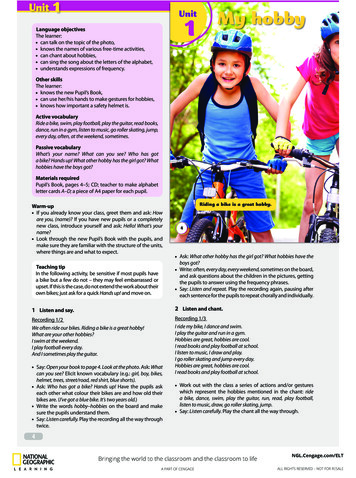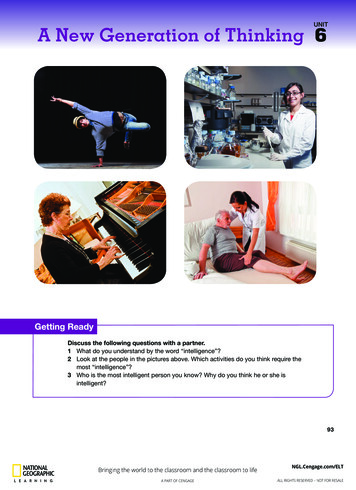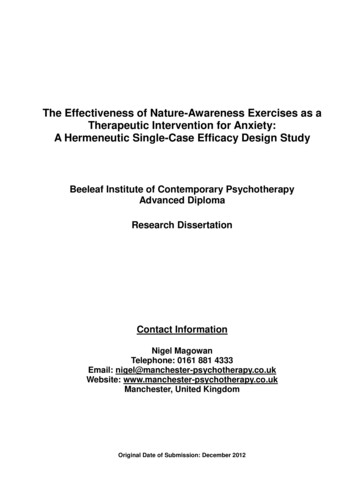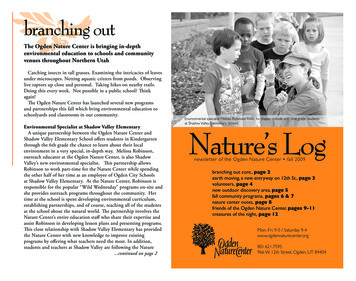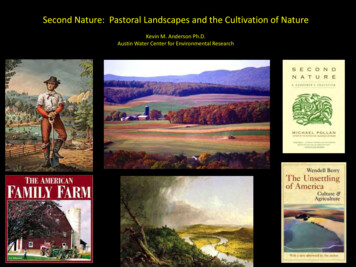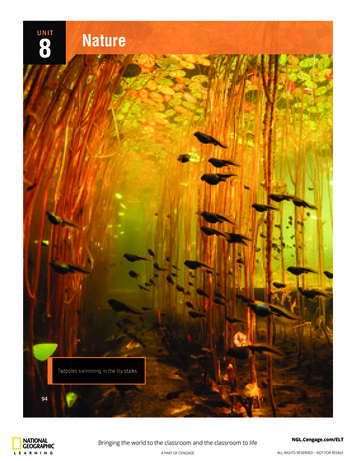
Transcription
UN I tNature8Tadpoles swimming in the lily stalks.9448709 se 02 u08 094-105.indd 942/28/14 12:28 PM
Look at the photo,answer the questions:1 What animals are these?Where do they usually live?2 How do they get their food?UNIT 8 GOALS1. Use conditionals to talk about real situations2. Talk about possible future situations3. Describe what animals do4. Discuss a problem in nature9548709 se 02 u08 094-105.indd 952/28/14 12:28 PM
AGOAL 1: Use Conditionals to Talk about Real SituationsPolar Bear (Ursusmaritimus) The polar bearis one of eight differentspecies of bears. Itshabitat is the ice andwater near the Arctic Circle.These bears arepredators that eat other animals.Their usualprey is otherarctic animals, such as seals.Theyhunt for their foodduring the day. This bear iswild and is found in thenorth of Canada. Polar bearsare vulnerable, and there arenot many of them left. Theirhabitat is shrinking. If wedon’tprotect these bears,they will becomeextinct.VocabularyA Read the text.B Match the words in blue to their meanings.1. to look for animals and kill them5. a kind of animal2. an animal that other animals killto eat6. doesn’t exist any more, all dead3. animals that kill other animals4. the place where an animalusually lives7. to keep safe from danger8. in nature, not controlled bypeopleGrammar: Real conditionals in the futureA Study the sentence and answer the questions.ConditionResultIf we don’t protect these bears, they will become extinct.1. Is the condition possible, or not possible?2. Is the result now, or in the future?Real conditionals in the future96We use the real conditional for s ituations that canhappen in the future.If you look out the train window, you will see a groupof wild deer.Conditional sentences have two clauses: the conditionclause, and the result clause.Condition: if subject simple present tense verbResult: subject will/be going to verbThe condition clause can be at the b eginning or end ofthe sentence.If you talk loudly, the birds will fly away.The birds are going to fly away if you talk loudly.Unit 848709 se 02 u08 094-105.indd 962/28/14 12:28 PM
B Complete the sentence with the correct form of the verb in parentheses.1. If an elephant(live) in a zoo, it2. We(be) very happy if our team3. If I(see) a bear in the forest, I4. I for a ticket.(go) to the concert if I5. If youC(get) bored.(win).(yell) loudly.(have) enough money(sleep, not) enough, you(feel) tired. Discuss these situations with a partner. Write sentences to describe themin your notebook. What will happen if . . .1. polar bears can’t find enough food?2. the polar bear’s habitat disappears?3. people put more polar bears in zoos?4. people protect polar bears?5. polar bears become extinct?Real LanguageYou can say That may be(true), but . . . to show thatyou disagree with the otherperson’s idea.ConversationA6 Close your book and listen to the conversation. What is Katie afraid of?Mike: Let’s go camping in the national park.Katie: I’m not sure that’s a good idea. There are black bearsin the park.Mike: That may be, but they’re not very big. And they stay awayfrom people.Katie: If I see a bear, I’ll be really scared. They’re so dangerous!Mike: Bears won’t hurt you if you leave them alone.BCD Practice the conversation with a partner. Switch roles andpractice it again.Make two new conversations.1. White Beach/sharks3. the nature reserve/snakes2. North Campground/wolves4. your own ideaGOAL CHECKUse conditionals to talk about real situationsLook at the problems in the box. How will these issues affect nature?Talk about them with a partner.climate changehuman population growthenergy usenature shows/other educationNature48709 se 02 u08 094-105.indd 97972/28/14 12:28 PM
BGOAL 2: Talk about Possible Future SituationsThese bluefin tuna from a fish farm inthe Mediterranean will become sushi inJapanese restaurants.1. Atlantic OceanListening2. Pacific OceanA Look at the map and match the places with the boxes on the map.3. Indian Ocean4. Mediterranean SeaB7 Listen to the radio program about the bluefin tuna and circle the threeplaces it talks about in the map.C8 Listen and fill in the blanks.Bluefin Tuna1. Up tofeet long4. Swims more than2. Weighs more thanmiles an hour3. Colors:D,5. Lives up to,years9 Listen and complete the sentences.people use it to make sushi, and in1. I nto cook big pieces for tuna steaks.2. If the boats3. Onlybig bluefins, thereyoung fish in the future.of the original population of bluefins was left.4. If the big boatspeople5. If this amazing fishE, people lovethe fishing in the Mediterranean, many poortheir jobs., the seasa great treasure.Discuss these questions with a partner.1. Is fish cheap or expensive where you live? How often do you eat it?2. Do you know where your fish comes from?98Unit 848709 se 02 u08 094-105.indd 982/28/14 12:28 PM
Pronunciation: Phrases in sentencesA10 Listen and repeat the sentences. Notice how they’re divided intophrases.1. A bluefin tuna can swim very fast and live a long time.2. My friend’s birthday is June fourteenth.B Draw lines to divide these sentences into phrases.1. Jeff and I saw three big sharks.2. Cathy isn’t here, but I can take a message.3. I’ll bring my camera if we go to the zoo.4. If they catch all the big fish, the species won’t survive.5. The family will have fun at the national park.C11 Listen and check your answers. Take turns saying the sentences.CommunicationWord FocusA Read the information. What does sustainable mean?Fish is one of the world’s favorite foods. Around the world, the average personeats 36 pounds (16 kg) of fish every year. But many kinds of fish around theworld are disappearing because people catch too many of them. Scientists saythat 90 percent of the biggest fish are gone now. If we catch too many big fishnow, there won’t be any baby fish in the future. Our way of fishing now is notsustainable—it can’t continue for a long time without hurting the environment.BRecycling used paper is goodfor the environment.This classroom is a goodenvironment for learning. You are members of an environmental group called Save the Oceans. Youwants to take action to solve the fishing problem. Talk about these plans.What will happen if we follow each one?Plan A: Don’t eat fish!Tell people to stop buyingand eating fish. Put ads innewspapers and magazines,and make TV commercials toexplain why fishing hurts theenvironment.CThe word environmentcan refer to nature or toeverything that’s around us.GOAL CHECKPlan B: Safe fish symbolMake a special symbol for fishthat is caught in a sustainableway. Make commercials to tellpeople to look for this symbol insupermarkets and restaurants.Plan C: Strict laws aboutfishing Make stronger lawsabout how many fish people cancatch. Send special police in fastboats to all of the fishing areasto make sure that fishing boatsfollow the laws.Talk about possible future situationsWhich is the best plan? Why? Explain your decision to the class.Nature48709 se 02 u08 094-105.indd 99992/28/14 12:28 PM
CGOAL 3: Describe What Animals DoLanguage Expansion: Adverbs of mannerAHow do they do it? Complete the sentences with an adverb from the box.1. A snail movesbeautifully fast wellslowly loudly badlyslowly2. A fox hunts4. A monkey jumps.3. A penguin walks.5. A lion roars.6. A bird sings.Adverbs of mannerAdverbs of manner tell us how an action is done. The adverb usually follows the verb.A snail moves slowly.Tigers run fast.Many adverbs of manner are formed from adjectives plus -ly.quick – quicklysoft – softlySome adverbs of manner are irregular.well fast hardNote: For most adjectives that end in -y, change the -y to -i and add -ly.easy – easilyangry – angrilyquick carefulquiet easy loudBsafe – safelycareful – carefullyhappy – happily In your notebook, write sentences using the adverb form of each adjectivein the box.Grammar: Review of quantifiersA Write C for count nouns or NC for non-count nouns.Raccoons are small (1)few (2)animals that live in North America, Japan, and aparts of Europe. They are omnivores—animals that eat both plantsand animals. A raccoon’s usual diet is (3)also like to eat insects. Sometimes they catch (5)nuts and (4)fish or (6)fruit. Theyfrogs.100 Unit 848709 se 02 u08 094-105.indd 1002/28/14 12:28 PM
QuantifiersWith count nounstoo fewa fewsomea lot ofmanytoo manyWith non-count nounseggstoo littlea littlesomea lot oftoo muchmeat*Quantifiers tell us how much or how many.*Don’t use much in affirmative sentences: He has much money. He has a lot of money.B Circle the correct quantifier in each sentence below.1. Raccoons eat ( many a little ) different kinds of food.2. They eat ( a little a lot of ) nuts.3. Raccoons will eat ( a few a little ) insects if they find them.4. They sometimes eat ( a little many ) soap.5. I f a raccoon goes in your garbage can, you’ll find ( a lot of many )garbage all over the place!ConversationA12 Listen to the conversation with your book closed. What does thewoman want to see at the zoo?Dan:Carmen:Dan:Carmen:So, which animals do you want to see at the zoo?I love to look at the penguins. I think they’re really amazing.Why is that?Well, they walk so slowly, but in the water they swim really well.And it’s fun to watch them at feeding time.Dan:Really? What do they eat?Carmen: They eat a lot of fish and a few shrimp.BC Practice the conversation with a partner. Switch roles and practice it again.Fill in the chart. Add your own ideas. Then make new conversations.What they doWhat they eat1. tigers2. elephantsDGOAL CHECKmeat walk playleaves grass swimrun fruitDescribe what animals doReport to the class. Tell them about your favorite zoo animal. Try to useadverbs and quantifiers.Nature48709 se 02 u08 094-105.indd 1011012/28/14 12:28 PM
DGOAL 4: Discuss a Problemin NatureReadingAWhat are some reasons animals areendangered? Talk about your ideas with apartner.BLook at the list of ways we can protectendangered animals. Check the ideas youpredict you will read about in the article.Compare your answers with a partner.1.2. create advertisements aboutconservation3.prevent droughts4.put land under conservation5.support nature tourism1.20 lions remain in Kunene2.John Kasaona is born3.drought hits Namibia4.war begins5.war endsList two good things about thecommunity based conservation program.Compare your answers with a partner.GLOSSARYbush n. land far from towns and citiesconfront v. to challenge (someone) in aforceful wayconservationist n. someone who works toprotect animals, plants, and natural resourcespoaching n. killing an animal illegallyspecies n. a group of animals or plants thatare similar102How PoachersBecameCaretakersstop poachingC Read the article. Write the dates next tothe events.DJohn KasaonaCommunity Based ConservationistJohn Kasaona’s idea worth spreading is thatNamibia’s community-led conservation program canbe a model for the rest of the world. It will help usprotect endangered animals while empowering andimproving the lives of rural people.When John Kasaona was a boy growing up inNamibia, his father took him into the bush to teach himhow to take care of the family’s livestock. His fathersaid, “If you see a cheetah eating our goat, walk upto it and smack it on the backside.” A cheetah is avery nervous animal. If a person confronts it, it willprobably run away. John also learned how to deal witha lion by standing very still and making himself lookvery big. These were useful lessons for a boy whobecame a wildlife conservationist. As Kasaona says,“it is very important if you are in the field to know whatto confront and what to run from.”Kasaona was born in 1971. At that time, Namibiahad many problems. The country was at war from 1966to 1990. Because of the fighting, many people hadrifles. This caused a secondary problem—poaching.For example, poachers killed many black rhinos fortheir horns, which were very valuable. To make thingseven worse, around 1980, a terrible drought killedpeople, livestock, and wildlife. By 1995, there were only20 lions left in the Kunene region in the northwest ofthe country, where Kasaona’s family lives. Many otherspecies were also endangered.Unit 848709 se 02 u08 102-104.indd 1022/28/14 12:29 PM
John Kasaona is aconservationist in Namibia.At the same time, positive changes were takingplace. A non-governmental organization, the IntegratedSince then, the situationRural Development andhas changed dramatically.Nature ConservationW eknewconservationwouldfailThe Kunene region now has(IRDNC) began workingmore than 130 lions. Thein Namibia to protectif it didn’t work to improve theblack rhino, almost extinctwildlife. They met withlives of the local communities.in 1982, has come backvillage leaders to ask–JohnKasaonaand there are now manywho would be able tofree-roaming black rhinos inwork with them. TheyKunene. Most importantly, more land than ever is underneeded people who knew the bush well, and whoconservation. That protected land generates moneyunderstood how wild animals lived. The answer wasfrom tourism for Namibia to use in education, healthsurprising: work with local poachers. It seemed crazy,care, and other important programs for its people.but it also made sense. After all, if you spend yourJohn Kasaona explains, “We were successful intime hunting for animals, you will know where theyNamibia because we dreamed of a future that waslive and how they behave. So IRDNC hired a groupmuch more than just a healthy wildlife.” That success isof poachers, including Kasaona’s own father, to helpnow a model for other African countries.protect wildlife in Namibia.“”TEDTALKS48709 se 02 u08 102-104.indd 1031032/28/14 12:29 PM
DGOAL 4: Discuss a Problem in NaturePoaching endangers species in their naturalhabitats.CommunicationAThink about two or three problems in nature in your country. Whatis happening? What is the cause? Share your ideas with a partner.WritingA Complete the sentences about a problem in nature in your country.1. If we believe in conservation, we will2. If., many animals will be saved.3. If people want to make positive changes, they will.B Write but, so, and even though in the correct places in the paragraph.By the 1990s, many species of animals were endangered in Namibia.The situation was serious, (1)conservationists neededto find a way to protect the animals. They found one, (2)it wasn’t what you would expect: they asked poachers for help.(3)Writing StrategyConjunctionsConjunctions are used toconnect ideas within sentences.this seemed crazy, I think it was a great idea. If we wantto protect endangered species, we need to consider every solution.C Write a paragraph in your notebook giving your opinion about aproblem in nature in your country. Be sure to use the connectors inExercise C.DGOAL CHECKDiscuss a problem in natureWork with a group. Share your ideas from Exercise A about problemsin nature. In your opinion, what is the most important problem tosolve? What are two or three ways to help?104Unit 848709 se 02 u08 102-104.indd 1042/28/14 12:29 PM
EVIDEO JOURNAL: Happy ElephantsBefore You WatchAElephants are a mazing animals. They can usetheir trunks to pick upheavy things. In thewild, they live in herds inthe forest. Today, manyelephants live in zoos.Their trainers take care ofthem. But can elephantsbe happy in captivity?Read about the video and check the meanings of the words in bold.While You WatchAWatch the video, Happy Elephants. Choose the main idea.1. Elephants are happier in the wild.2. People and elephants have been together for a long time.3. Elephant trainers find ways to make elephants happier.BWatch the video again. Fill in the information.1. Elephants and people have worked together for overyears.2. There is one question that people have been asking: How is it possible to keepelephants happy?3. Many people who work closely with animals say that they do haveand can experience happiness.4. That means that they live in families and herds and theyother elephants.5. For elephants, communication and social relationships are really.After You WatchA Discuss these questions with your partner. Have you visited a zoo, or seen avideo of a zoo? Do you think the animals like living there? Why, or why not?Nature48709 se 02 u08 094-105.indd 1051052/28/14 12:28 PM
Beverly and Dereck Joubert Documentary Filmmakers/Conservationists, National Geographic Explorers in ResidenceLife Lessons From Big CatsBefore You WatchAhave (4)Look at the picture and answer thequestions with a partner.in the last50 years. And it’s not only the big cats thatare in danger – eco-tourism brings in a large(5)to Africa. If the catsdisappear, so will the money and jobs.C Beverly and Dereck Joubert are wildlifephotographers who publicize the problem ofendangered big cats. What do you predictyou will hear in their TED Talk? Look atthe pictures on the next page. Check theinformation you predict you will hear.1. We have spent five years watching aleopard cub grow up.1. What kind of animal is in the photo?2. Where do these animals live?2. We are also researching the behavior ofgiraffes and elephants.3. What else do you know about these animalsand their habitat?3. Our investigations have shown that theselions are essential.B Look at the words in the box. Complete theparagraph with the correct word. Not all wordswill be used.collectively adj. shared or done by a group ofpeoplecondone v. to allow (something that is consideredwrong) to continuecrash v. to go down very suddenly and quicklydisrupt v. to cause (something) to be unable tocontinue in the normal waypride n. a group of lionsrevenue stream n. a flow of money that is madeby or paid to a business or an organization4. Lion bones are being sold.While You WatchAWatch the video. Circle the main idea.1. It’s necessary to study big cats over manyyears.2. If the big cats disappear, many otherspecies may disappear.3. Beverly and Dereck Joubert believe thatbig cats are beautiful.Africa’s big cats are endangered, and weare all (1)Soon, the (2)responsible.oflions may disappear. Because we(3)hunting and otheridea worth spreading is that big cats areessential to the survival of entire ecosystems,including their human neighbors. The Joubertsbelieve we must change our relationship with thebig cats and respect and celebrate them. Watch theJoubert’s full TEDTALK on TED.comactivities that put them at risk, their numbers118TEDTALKS48709 se 02 u08 118-121.indd 1182/28/14 12:32 PM
“ And I know, in the light of humansuffering and poverty and evenclimate change, one would wonder,why worry about a few cats?”– Beverly JoubertB Watch the video again and match the photo to thecorrect caption.1.a. I f a male lion is killed, themembers of his pride may also diec. Legadema trusts the Jouberts andlets them come close to her.b. T he Jouberts have discovered thatsome lions hunt in the water.d. T he Jouberts have studied ayoung leopard named Legademasince she was a baby.2.3.4.TEDTALKS48709 se 02 u08 118-121.indd 1191192/28/14 12:32 PM
Beverly and Dereck Joubert Documentary Filmmakers/Conservationists, National Geographic Explorers in ResidenceLife Lessons From Big CatsAfter You WatchA Complete the summary with the words in the y and Dereck Joubert are (1)surviveabout protecting the African wilderness.They have spent many years studying and (2)these cats have been pushed to the edge of (3)believe that if the big cats are viewed with (4)big cats (5)big cats. In the last 50 years,by hunters. The Jouberts, they can survive. And if the, they can help us maintain our connection to nature and to otherhuman beings.B Match the phrases to state information from the video.1. number of lions alive nowa. 80 billion2. number of leopards left in the wildb. 53. years the Jouberts have been filming big catsc. 20,0004. amount of ecotourism revenue streamd. 50,0005. number of years the Jouberts followed Legademae. 28C Read the statements below. Circle the ones that paraphrase theJouberts’ opinions in the video.1. Many kinds of big cats live in the African wilderness.2. It’s important to protect big cats and the humans who livenear them.3. There used to be more than 450,000 lions in Africa.4. It is wrong to hunt and kill lions for sport.5. If we aren’t connected to nature, we will lose hope.120TEDTALKS48709 se 02 u08 118-121.indd 1202/28/14 12:32 PM
Beverly and Dereck Joubert want to protect the African wilderness. Use their ideasto write a letter in support of big cat conservation to the editor of a newspaper inyour country. Follow these steps.DWork with a partner to find facts and opinions from the video you caninclude. Complete the chart below. Choose the ones that support your ideathe best.FACTOPINIONE Write your letter. Use the frame below to organize your ideas. Then show yourletter to a different partner. Is your opinion easy to understand? Does he or shehave ideas for improvement?To the Editor:I am writing to (1). In my opinion, (2), we will (4).It is also important to (5)Finally, I think (8). If we don’t (3). We will (6). If (9), then (10)if we (7).Yours sincerely,Challenge!Beverly and Dereck Joubert are working to ensure the long-termsurvival of big cats. Find out more about the Big Cats initiative at TED.com andexplore ways you can get involved. Share what you learn with the class.TEDTALKS48709 se 02 u08 118-121.indd 1211212/28/14 12:32 PM
98 Unit 8 B GOAL 2: Talk about Possible Future Situations Listening A Look at the map and match the places with the boxes on the map. B 7 Listen to the radio program about the bluefin tuna and circle the three places it talks about in the map. C 8 Listen and fill in the blanks. Bluefin Tuna 1. Up to feet long 2. Weighs more than 3. Colors: , , 4. Swims more than


